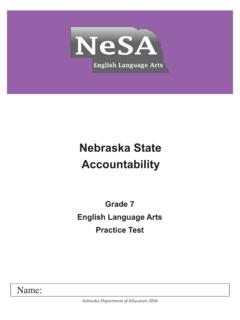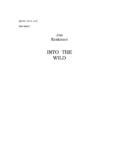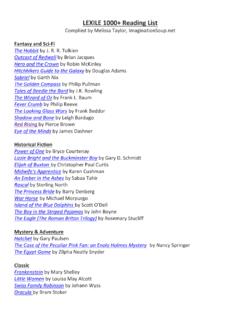Transcription of 19th-century literature at Key Stage 3 - AQA
1 19th - century literature at Key Stage 3 Teaching resources to help you develop the confidence of your Key Stage 3 students when reading 19th - century 19th - century literature at Key Stage 3 4 Childhood and family 1: motherless children 5 Dombey and Son by Charles Dickens (1848) 7 Oliver Twist by Charles Dickens (1838) 11 Silas Marner by George Eliot (1861) 13 Childhood and family 2: education 17 Jane Eyre by Charlotte Bronte (1847) extract 1 18 Nicholas Nickleby by Charles Dickens (1839) extract 1 19 Jane Eyre by Charlotte Bronte (1847) extract 2 20 David Copperfield by Charles Dickens (1850) 20 Nicholas Nickleby by Charles Dickens (1839) extract 2 21 Hard Times by Charles Dickens (1854) 22 Jane Eyre by Charlotte Bronte (1847) extract 3 24 Childhood and family 3.
2 Girls and boys 26 Wuthering Heights by Emily Bronte (1847) 27 The Mill on the Floss by George Eliot (1860) 30 Northanger Abbey by Jane Austen (1817) 35 Tess of the D Urbervilles by Thomas Hardy (1891) 37 Childhood and family 4: a woman s place 40 Mansfield Park by Jane Austen (1814) 42 Great Expectations by Charles Dickens (1861) 43 The Mayor of Casterbridge by Thomas Hardy (1886) 44 Sense and Sensibility by Jane Austen (1811) 52 Adventure and mystery 1: the adventure begins 55 Moonfleet by J. Meade Faulkner (1898) 57 King Solomon s Mines by H. Rider Haggard (1885) 61 The Sign of Four by Sir Arthur Conan Doyle (1890) 6219TH- century literature AT KEY Stage 33 Adventure and mystery 2: the good the bad and the ugly: characters in adventure stories 65 Treasure Island by Robert Louis Stevenson (1883) 66 Dr Watson s description of Sherlock Holmes from A Study in Scarlet by Sir Arthur Conan Doyle (1887) 69 Adventure and mystery 3: man s best friend?
3 Animals in the 19th - century literature 72 The Call of the Wild by jack london (1903) 73 Black Beauty by Anna Sewell (1877) 76 Oliver Twist by Charles Dickens (1837) 78 Adventure and mystery 4: real adventure during the 19th century exploration and colonialism 80 Robert Falcon Scott (1868-1912) 81 David Livingstone (1813-1873) 87 Robinson Crusoe by Daniel Defoe (1719) 8819th- century settings 1: the Gothic tradition 93 Frankenstein by Mary Shelley (1818) 94 Northanger Abbey by Jane Austen (1817) 95 Wuthering Heights by Emily Bronte (1847) 99 Lockwood s dream Dracula by Bram Stoker (1897) 100 The Hound of the Baskervilles by Sir Arthur Conan Doyle (1902) 10219th- century settings 2.
4 Working life in rural and urban settings in 19th - century literature 104 Tess of the D Urbervilles by Thomas Hardy (1891) 105 Mary Barton by Elizabeth Gaskell (1848) 1084 Introducing 19th - century literature at Key Stage 3 Teaching resourcesThis is a resource to help you develop the confidence of your Key Stage 3 students when reading 19th - century literature . It will introduce skills that will be relevant to the study of literature at Key Stage 4, and help your students develop their understanding of contexts, as well as some of the conventions established in literary to GCSE LiteratureUnderstanding and respondingAO1 Read, understand and respond to should be able to.
5 Maintain a critical style and develop an informed personal response use textual references, including quotations, to support and illustrate readingAO2 Analyse the language, form and structure used by a writer to create meanings and effects, using relevant subject terminology where contextAO3 Show understanding of the relationships between texts and the contexts in which they were are required to show the abilities described in AO1, AO2 and AO3 through tasks which require them to make comparisons across resource includes: three sections: Childhood, Adventure and Mystery, and C19th Settings extracts of texts, providing satisfying reading, and plenty of opportunity for discussion and exploration suggestions for further reading of whole books, including both 19th century and modern each topic, we ve provided suggestions for the learning focus, with activities for reading, discussion and sometimes for writing.
6 You ll have plenty of material to adapt and use over a number of sessions. 19th - century literature AT KEY Stage 35 Childhood and family 1: motherless childrenAims: to understand family relationships in 19th - century literature to understand aspects of the social and historical context of the 19th century to understand the use of orphans and vulnerable children as a literary for starter or hook Share examples from modern literature and films of vulnerable or orphaned child characters. Consider news stories about children and the ways in which they are presented. Discuss how we respond to such stories in real life and in the 19th - century context Mother and infant mortality rates.
7 Workhouses and other provision for destitute people in your local and Son by Charles Dickens (1848)Oliver Twist by Charles Dickens (1838)Silas Marner by George Eliot (1861)Understanding and respondingExtract 1 Dombey and Son by Charles Dickens (1848)This scene at the birth of Dombey s second child reminds us that childbirth in the 19th century was dangerous for both women and their babies. Identify the details that suggest that Mrs Dombey will are the reader s impressions of Dombey? What are his main concerns? How can we tell that he takes great pride in his family name and business?
8 Does he have the same pride in all the members of his family?Florence, aged six, is Dombey s first child. What do you notice about the way in which she is treated by the adults in this passage? What do you understand about her relationship with her father? And her mother?What does Dombey s sister, Louisa, bring to our understanding of characters and the Dombey family?Discuss what this passage shows about men, women and marriage in the 19th does this opening chapter show us about the business of Dombey and Son, and its reputation in society?By the end of the chapter a mother has died leaving her new baby and a young daughter.
9 A businessman has been widowed and is left with the care of two young children. Where does your sympathy lie? What do you think will happen next with the family?Closer reading1. Examine the structure of the sentences in the first three paragraphs. What pattern has the author used? How does this pattern introduce us to the characters and the business of Dombey and Son?2. Examine the nouns and noun phrases that Dickens has used for characters in this passage, and consider how they contribute to our understanding of the characters, their relationships and their values. The baby is referred to as Son with a capital letter.
10 Later, we learn that he will be given the name Paul. Dombey addresses his wife as Mrs Dombey and only hesitatingly, and only once, uses the term of endearment my dear . Florence is described as a piece of base coin and a bad Boy . Her father refers to her as the person .6 The only utterances that Florence makes address her mother as Mama .3. Read this paragraph again: Those three words conveyed the one idea of Mr Dombey s life. The earth was made for Dombey and Son to trade in, and the sun and moon were made to give them light. Rivers and seas were formed to float their ships; rainbows gave them promise of fair weather; winds blew for or against their enterprises; stars and planets circled in their orbits, to preserve inviolate a system of which they were the the details that refer to the natural world.
















